Chapter: Biochemistry: Vitamins
Water soluble vitamins
Classification
Vitamins are generally classified into two main
groups. (i) fat soluble vitamins (ii) water soluble vitamins.
2. Water soluble vitamins
The members of this group are B complex
vitamins and vitamin C. They are readily soluble in water.
B Complex vitamins
i. Thiamine (B1)
The structure of vitamin B1 is given
in Fig. 8.5.
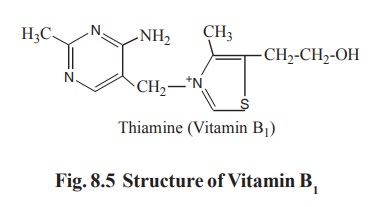
Functions
Thiamine act as a coenzyme in the form of
thiamine pyrophosphate in many enzyme systems. These are involved principally
in the breakdown of glucose to yield energy.
Thiamine also aids in the formation of ribose,
a sugar that is an essential constituent of DNA and RNA, the carriers of the
genetic code. The adequate level of thiamine provides healthy nerves, a good
mental outlook, a normal appetite and food digestion.
Sources
Meats, especially pork and liver are rich in
thiamine and account for about one fourth of the average intake. Dry beans,
peanuts and egg are good sources.
Whole grain breads and cereals supply about one
third of the daily thiamine intake.
Requirements
The requirement of thiamine depends on energy
expenditure.
Infants - 0.3 - 0.5 mg / day
Children - 0.7 -1.2 mg / day
Adults - 1.2 - 1.5 mg/day
Pregnant women and lactating women - 1.3- 1.5 mg/day
Absorption and storage
Free thiamine is readily absorbed from the
small intestine. Excess thiamine administered is not stored in the tissues. A
part of the excess thiamine is excreted in urine and same of it is destroyed by
the enzyme thiaminase.
Deficiency
The symptoms of thiamine deficiency occur
because the tissue cells are unable to receive sufficient energy from glucose.
Therefore, they cannot carry out their normal functions.
Early symptoms of thiamine deficiency include
fatigue, irritability, depression and numbness of the leg and poor tone of the
gastro intestinal tract together with constipation.
Beriberi,
sometimes called “rice-eaters disease” is
another deficiency symptom which is
often seen in people whose chief diet is refined rice and is the most severe
form of thiamine deficiency.
ii. Riboflavin (B2)
Structurally vitamin B2 consists of
a ribitol moiety and a substituted isoalloxazine ring (Fig. 8.6).
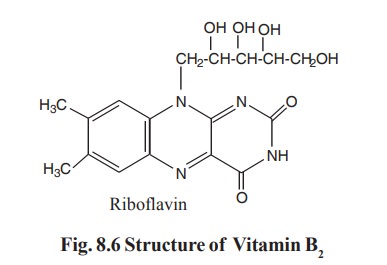
Functions
Riboflavin is a constituent of a group of
enzymes called “flavoproteins”. As with thiamine, the enzymes are necessary in
the break down of the glucose to form energy. Riboflavin is essential for a
healthy skin and for good vision in bright light. If the individual ingest more
riboflavin than their body needs, the urinary excretion will increase, if the
intake is inadequate, the body maintains its supply very carefully and the
urinary excretion will practically stop.
Sources
About half of the intake of riboflavin daily is
furnished by milk alone and cheese is a good source, although some of the
vitamin has been lost in the whey.
Requirements
A more generous estimate of requirements is the
level of intake at which there is normalisation of the activity of the red cell
enzyme glutathione reductase, which
is a flavoprotein whose activity is especially sensitive to riboflavin
nutritional status.
Infants - 0.4 - 0.6 mg / day
Children - 0.8 - 1.2 mg / day
Adults male - 1.5 -1.8 mg/day
Adults female - 1.1 - 1.4 mg/day
Pregnant women - 1.4 - 1.7 mg/day
Lactating women - 1.6 - 1.9 mg / day
Absorption and storage
The vitamin is phosphorylated in the intestinal
mucosa during absorption. It is absorbed from the small intestine through the
portal vein and is passed to all tissues being stored in the body. The major
part is excreted in urine and a small part is metabolized in the body.
Deficiency
Riboflavin deficiency leads to cheilosis, a
cracking of the skin at the corners of the lips and scaliness of the skin
around the ears and nose. There may be redness and burning as well as itching
of the eyes, and extreme sensitivity to strong light.
iii. Niacin (B3)
Niacin is pyridine-3-carboxylic acid (Fig.
8.7). It occurs in tissues as nicotinamide.
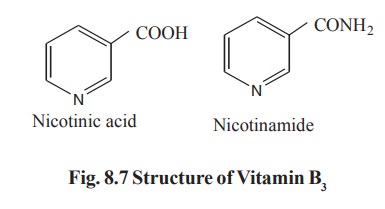
Functions
Niacin is required for the stepwise breakdown
of glucose to yield energy. Niacin is essential for the healthy skin, normal
functions of the gastro intestial tract and maintenance of the nervous system.
Sources
The meat group especially organ meats and
poultry, is the chief source of preformed niacin. Dark green leafy vegetables,
whole grain, enriched breads and cereals are fair sources.
Niacin is more stable to cooking procedures
than thiamine or ascorbic acid (Vitamin C).
Requirments
The recommended niacin allowance is 6.6 mg/1000
k cal. This can be supplied by exogenous niacin in the diet and by the
tryptophan, an essential aminoacid that is the precursor of niacin
biosynthesis.
Infants - 5 -8 mg / day
Children - 9 - 16 mg / day
Adults male - 16 - 20 mg/day
Adults female - 12 - 16 mg/day
Pregnant women - 14 - 18 mg/day
Lactating women - 16 - 20 mg / day
Absorption and storage
Nicotinic acid and nicotinamide are absorbed
from the intestine through the portal vein into the general circulation. Excess
nicotinic acid is not stored in the body.
Deficiency
Pellagra
is the major deficiency disease resulting from
the lack of niacin. Dermatitis, especially
of the skin exposed to the sun, soreness of the mouth, swelling of the tongue,
diarrohea, and mental changes including depression, confusion, disorientation,
and delirium are typical of the advancing stages of the disease, which ends to
death if not treated. (The disease is sometimes referred to as the “4D’S” -
dermatitis, diarrohea, dementia and death).
iv. Pyridoxine (B6)
Pyridoxine is 3-hydroxy 4,5 dihydroxy methyl -
2- methyl pyridine (Fig 8.8) The metabollically active form of vitamin B6
is pyridoxal phosphate.
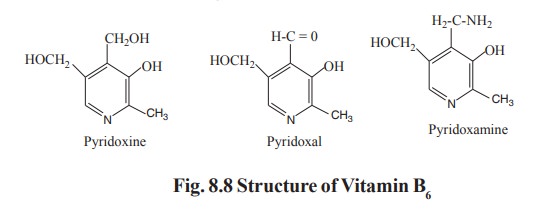
Functions
Three forms of vitamin B6 exist in
nature which are pyridoxine, pyridoxal and pyridoxamine. The functions of
vitamin B6 are closely related to protein metabolism, the synthesis
and breakdown of amino acids, conversion of tryptophan to niacin, the
production of antibodies, the formation of heme in hemoglobin, the formation of
hormones important in brain function and others.
Sources
Meat, especially organ meats, whole grain
cereals, peanuts and wheat germ are rich sources. Milk and green vegetables
supply smaller amounts.
Requirements
Although most of the body’s vitamin B6
is associated with glycogen phosphorylase in muscle, this is relatively stable
and well conserved.
The requirement depends not on energy
expenditure and glycogen metabolism, but on the intake of protein. The average
requirement is 13 μg/g dietary protein.
Infants - 0.3 mg / day
Children - 0.6 - 1.2 mg / day
Adults - 1.6 - 2 mg/day
Pregnant and lactating women - 2.5 mg/day
Absorption and storage
Pyridoxine is readily absorbed from the small
intestine. The excess amount if ingested is not stored in the body but is
excreted in urine.
Deficiency
Deficiency of vitamin B6 is
extremely rare. Nervous disturbances such as irritability, insomnia, muscular
weakness, fatigue and convulsion have been recorded in infants. The cause of
the convulsions severe impairment of the activity of the enzyme glutamate
decarboxylase, which is dependent on pyridoxal phosphate. The product of
glutamate decarboxylase is GABA (γ-amino
butyric acid) which is a regulatory neurotransmitter in the central nervous
system.
v. Folic acid
Folic acid contains a pteridine group linked to
para amino benzoic acid and l-glutamic acid (Fig. 8.9). It is slightly soluble
in water and stable to heat.
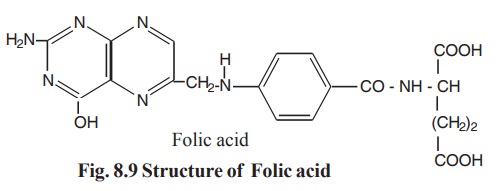
Functions
·
Folic
acid serve as coenzymes in reactions involving the transfer of one carbon units
like formyl and methyl groups.
·
It
participates in the reactions concerned with the synthesis of purine,
pyrimidine and nucleic acids.
·
It is
essential for maturation of red blood cells.
·
Folic
acid is required for the metabolism of amino acids like histidine.
·
Along
with vitamin B12, folic acid helps in the trans methylation
reactions. eg: uracil to thymine.
Sources
Folic acid is particularly present in green
leafy vegetables, cauliflower and dried yeast. Egg, liver and kidneys are rich
animal sources.
Requirements
There is no definite requirement for normal
human being. However, an increased amount is required during pregnancy and
lactation.
Infants - 50 μg / day
Children - 100 - 300 μg / day
Adults - 400 μg/day
Pregnant women - 800 μg / day
Lactating women - 600 μg/day
Absorption and storage
Absorption of folic acid takes place along the
whole length of the mucosa of the small intestine. Folic acid about (5-15 mg/g)
is in the liver and folate is also incorporated into the erythrocytes during
erythropoiesis (Red blood cells production).
Deficiency
Deficiency of vitamin B12 also leads
to functional folic acid deficiency.
·
Folic
acid deficiency leads to megaloblastic anemia characterised by the release of
large sized immature red blood cells into the circulation.
·
Sprue
and symptoms like glossitis and gastro intestinal disturbances have also been
reported.
·
Macrocytic
anemia of pregnancy responds to treatment with folic acid.
vi. Vitamin B12
Structure of vitamin B12
Structurally, vitamin B12 consists
of a corrin nucleus attached with 5,6 dimethyl benzimidazole moitey, an
aminopropanol unit, a ribose unit and a phosphate group. A cobalt atom (Co) is present
at the centre of the corrin ring structure. One of the valencies of cobalt is
filled by either CN- (cyano cobalamin) or H2O (aqua cobalamin) or
OH- (hydroxo cobalamin) or CH3 (methyl cyano cobalamin).
Functions
Of all vitamins, vitamin B12 is the
most complex. The trace mineral cobalt is an essential part of the molecule.
Vitamin B12 is required for the maturation of red blood cells in the
bone marrow and for the synthesis of proteins.
Sources
Milk, eggs, cheese, meet, fish and poultry
supply ample amounts of vitamin B12. Plant foods supply no vitamin B12
and use of an exclusively vegetarian diet for a long period of time will lead
to symptoms of deficiency.
Requirements
Early estimates of vitamin B12
requirements were based on the amounts required to maintain normal RBC
maturation in patients with pernicious anemia due to lack of intrinsic factor
secretion. There is a considerable enterohepatic circulation of vitamin B12.
It is secreted in the bile and re-absorbed in the small intestine. However, in patients
with defective secretion of intrinsic factor, the vitamin cannot be
re-absorbed, but is excreted in the feces. This means that patients with
impaired secretion of intrinsic factor have much higher requirement for vitamin
B12 than normal.
The average requirement of vitamin B12 is 3 μg/day.
Infants - 0.3 μg / day
Children - 1 - 2 μg / day
Adults - 3 μg/day
Pregnant and lactating women - 4 μg / day
Absorption and Storage
For the absorption of vitamin B12
from the intestines, a factor called “Intrinsic Factor” (IF) secreted by the
stomach is essential. Vitamin B12 is stored in fair amounts in the
liver.
Deficiency
Pernicious anemia is the disease resulting from
vitamin B12 deficiency. It is a genetic defect with the absence of
intrinsic factor, hence the vitamin B12 in the diet cannot be
absorbed. Since vitamin B12 is important for the maturation of red
blood cells the deficiency of this vitamin leads to the formation of macrocytic
red blood cells.
vii. Pantothenic acid (B5)
The structure of pantothenic acid consists of
an alanine chain in peptide linkage with dihydroxy, dimethyl butyric acid (Fig.
8.10).
Pantothenic acid is highly soluble in water.
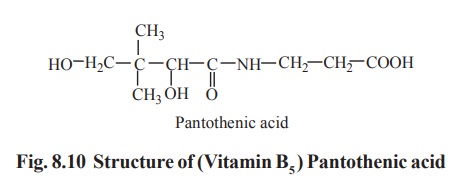
Functions
Pantothenic acid exists in the free form and in
combination with b- mercapto ethylamine, adenine ribose and
phosphoric acid. The later form is called as co-enzyme A (CoA).
The metabolic functions of pantothenic acid are
due to its coenzyme derivative CoA, which participates in several metabolic
reactions. CoA gains further importance after its conversion to form acetyl
CoA.
·
Acetyl -
Co A plays a key role in carbohydrate, protein and lipid metabolism.
·
Acetyl -
Co A is the precursor of cholesterol. It is the main source for the synthesis
of cholesterol as well as steroid hormones.
·
Acetyl -
Co A combines with choline to form acetyl choline.
·
Some of
the amino acids require Co A for their activation.
Sources
Dried yeast, liver, royal gelly are the rich
sources of pantothenic acid. Egg yolk, meat, fish, milk are good sources.
Requirements
The recommended daily allowance of pantothenic
acid as follows:
Infants - 1.5 - 2.5 mg/day
Children - 5 - 8 mg/day
Adults - 5-12 mg/day
Pregnant and lactating women - 10-15 mg/day.
Absorption and sotrage
Pantothenic acid and its salts are readily
absorbed from the small intestine through the portal vein into the general
circulation. If ingested in excess of the requirements, it is not stored in the
body; but is excreted in urine or metabolised by the tissues.
Deficiency
Deficiency of this vitamin results in nausea,
vomitting, certain gastro intestinal tract disorders, inadequate growth,
anemia, fatty liver and failure in gaining weights.
viii. Biotin
Biotin is a heterocyclic, sulphur containing
monocarboxylic acid (Fig. 8.11). Biotin is sparingly soluble in cold water and is
freely soluble in hot water.
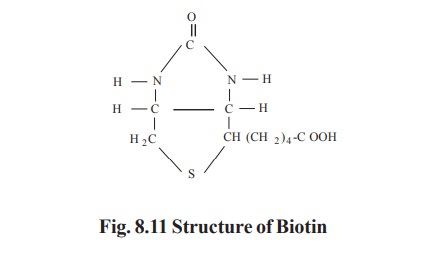
Functions
Biotin is required as the co-factor for a small
number of carboxylation reactions, it acts as the carrier for carbon dioxide.

·
It helps
to maintain the skin and the nervous systems in good condition.
·
It
assists in the deamination of amino acids like aspartic acid, serine and
threonine.
·
It helps
in the synthesis of purine.
·
For the
conversion of ornithine to citrulline in the synthesis of urea, biotin is
required.
Source
Biotin occurs widely both in foods of vegetable
and animal origin. Wheat germ, liver, peanut, and rice polishings are rich
sources. Whole cereals, legumes, mutton and egg are good sources.
Requirements
Since, intestinal bacteria and diets supply
biotin in adequate amounts the deficiency of this vitamin in human being is
rare.
Infants - 10- 15 μg/day
Children - 20-40 μg/day
Adults - 50-60 μg/day
Absorption and Storage
Biotin is readily absorbed from the small
intestine through the portal vein into the general circulation. Excess of the
requirements is not stored in the body but is mostly excreted in the urine.
Egg white injury factor (Avidin)
There is a protein in egg white called avidin
which is responsible for producing egg white injury. Avidin binds with biotin
tightly in the intestinal tract and prevents absorption of biotin from intestines.
Avidin is denatured by cooking and then loses its ability to bind with biotin.
The amount of avidin in uncooked egg white is relatively small, and problems of
biotin deficiency have only occurred in people eating abnormally large amounts
of raw eggs for many years.
Deficiency
Deficiency of biotin is rare in human beings.
Vitamin C (Ascorbic Acid)
Vitamin C is also called as ascorbic acid (Fig.
8.12).
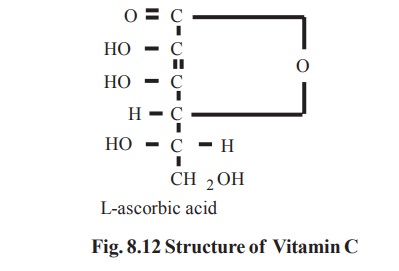
Functions
·
Vitamin
C is essential for building collagen the connective tissue protein which
cements the cells and tissues together. The effect of this material is to
provide firm tissues of all kinds. This vitamin helps forming strong blood
vessels, teeth firmly held in their sockets, and bones firmly held together.
·
It has a
general antioxidant role, especially in the regeneration of oxidized vitamin E
in membranes.
·
Ascorbic
acid reduces the ferric ion (Fe3+) to ferrous (Fe2+) ion
and thus helps in the absorption of iron. It is also essential for rapid
healing of wounds.
Sources
Raw fresh vegetables contain vitamin C, but
some foods are more outstanding than others. Orange, grape, lime and lemon are
especially rich in vitamin C.
Requirements
Recommended amount of vitamin C for different
age group is as follows:
Infants - 35 mg / day
Children - 40 mg / day
Adults - 45 mg / day
Pregnant women - 60 mg / day
Lactating women - 80 mg / day
Absorption and storage
Ascorbic acid is rapidly absorbed from the
intestines and passed on through the portal vein to the general circulation.
Liver and other organs and tissues have an optimal level of ascorbic acid.
Excess intake do not increase further the optimal levels.
Deficiency
Severe deficiency of vitamin C leads to scurvy. This is characterised by easy
bruising and hemorrhaging of the skin, lossening of the teeth, bleeding of the
gums and distruption of the cartilages that support the skeleton.
Related Topics